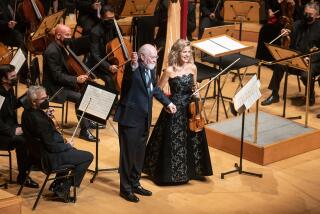MUSIC REVIEWS : Violin Concerto Caps Evening With the Camerata
NEWPORT BEACH — Music director Ami Porat led the Mozart Camerata in an energetic and rewarding program dominated by a captivating performance of Mendelssohn’s D-minor Violin Concerto Saturday night at St. Andrew’s Presbyterian Church.
Concertmaster Clayton Haslop downplayed the Classical roots of this early work (written when the composer was 13) by de-emphasizing its elegance and simplicity in favor of its dramatic content. He exploited the contrasts between lyricism and virtuosic passages with stylish flair, and seemed to savor each note of the passionate Andante, while his accompanists communicated a sense of pathos and urgency.
Throughout the evening, Porat extracted similarly involving--if not always technically pristine--playing from his skillful group. J.C. Bach’s Sinfonia in C, Opus 3, No. 2, benefited from vigorous presentation, minute control of dynamics and effective balances, but sometimes fell prey to imprecise entrances and sloppy tuttis.
The long plaintive melody of the poco Andante from the Sinfonia in E, WQ 182, No. 6, by C.P.E. Bach, unfolded affectingly, little hindered by sporadic glitches in intonation, while the outer movements received animated readings.
According to his own printed notes, Porat chose to omit basso continuo on the defensible (although unpopular among authentic-instrument aficionados) assumption that “the need for harpsichord during modern performance has been eliminated by the clear vertical strength of the string writing.” Certainly, the volume of 24 modern string instruments would greatly have outweighed that of a harpsichord.
The final offering of the evening was Johan Baptist Vanhal’s Sinfonia in G minor, a charming sample of early-Classical style by this prolific but now little-known Czech composer. The Andante Cantabile emerged with particular poignancy due largely to graceful alternating solos and duets by Haslop and principal violist Simon Oswell.
During the final two movements, however, horns struggled fitfully to find their pitches.
As an encore, the strings dispatched the Allegro from Mozart’s Divertimento in B-flat, K. 137, tidily and with characteristic verve.
More to Read
The biggest entertainment stories
Get our big stories about Hollywood, film, television, music, arts, culture and more right in your inbox as soon as they publish.
You may occasionally receive promotional content from the Los Angeles Times.










